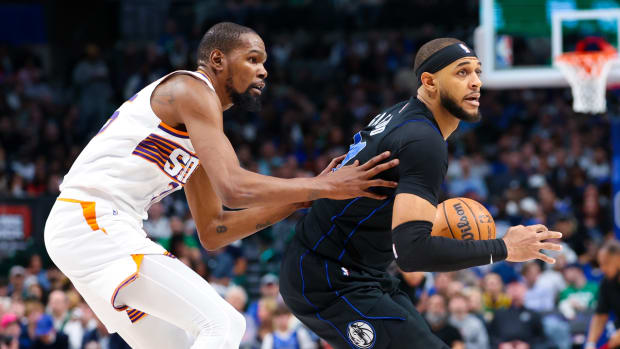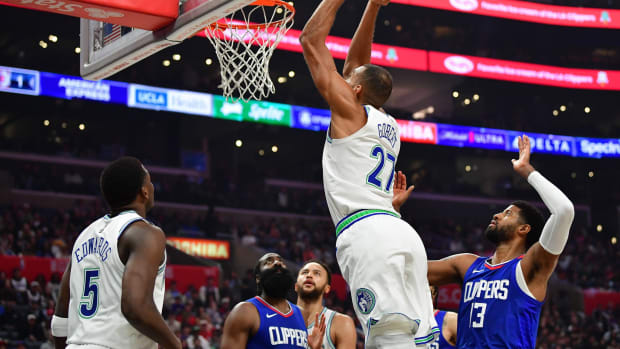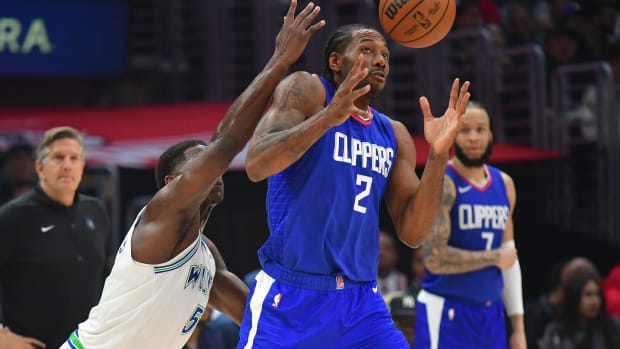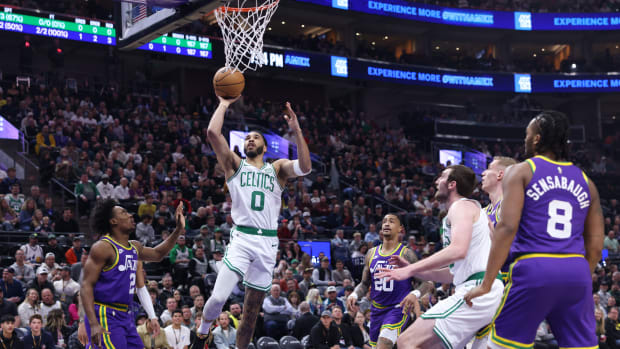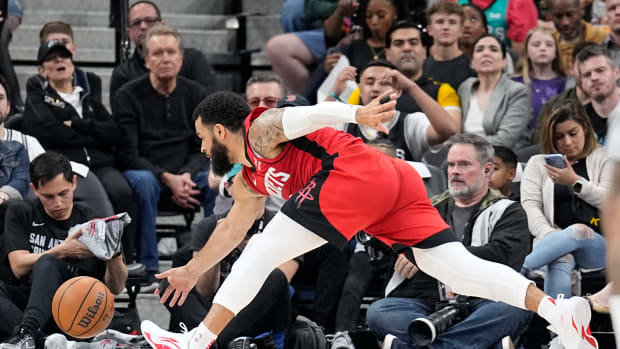Do James Harden and Joel Embiid Make Sense Together?
(Editor's note: This story was originally published on Feb. 8 and has since been updated with news of the Sixers-Nets deal on Thursday.)
After a blockbuster trade on Thursday afternoon, James Harden and Joel Embiid are officially teammates.
In a deal that sent Harden and Paul Millsap to the Sixers for Ben Simmons, Seth Curry, Andre Drummond and two first-round picks, the NBA’s most fascinating star tandem is now real.
They still haven’t played a minute together, but both superstars are well known personalities with preferred playing styles. Their theoretical co-existence is no great mystery. Hundreds of games between the two help provide a road map toward understanding how they’d organically complement one another while inducing mutual sacrifice and adaptation.
They make sense as an extremely attractive partnership in some straightforward ways, but above all else it’s worth considering how effective Embiid and Harden are as independent offenses unto themselves. There’s only one ball isn't usually a concern worth subscribing to, but this pair pushes any such warning label to the edge. Both love having it in their hands. Over the past five seasons, Harden ranks first in usage (35%) and Embiid—who currently leads the league in this category—ranks third (34.2%).
For a big man, Embiid isn’t spoon-fed. Only half of his baskets are assisted by a teammate, a number that places him in the 95th percentile among centers. Likewise for the 32-year-old Harden, who ranks in the 91st percentile among point guards. According to Synergy, this is his eighth straight season leading the NBA in isolation possessions per game and his fifth straight season on top in isolation frequency. The gap between him and everybody else has narrowed since he joined the Nets, but one-on-one confrontations remain his bread and butter.
Building an efficient offense around two self-sufficient weapons of Harden and Embiid’s magnitude wouldn’t be simple. At the same time, stars tend to have an easier go when beside each other. Suddenly, sending a second defender at Harden, or even just shading another body behind his initial man, is far more complicated with Embiid standing in the dunker spot or alone on the opposite wing. And at the same time, swarming Embiid in the post with Harden one pass away isn’t tenable.
Appeasing both by balancing the volumes they’ve grown accustomed to may not be possible, though. Unless they’re staggered dramatically, it might also turn each into an overqualified, extremely expensive role player off the ball. Put another way: Harden can elevate Philly’s system as it currently exists, but it could also shape itself around his personal preferences. The connection here would be entirely new, too. Harden has never played with a physically overpowering center who devours the left block and dines in the midrange. Meanwhile, Embiid has never known a ball-dominant pick-and-roll playmaker who’s happy launching step-back threes. How they’d interact would suddenly become the most important question in the NBA.
On paper, their two-man game is diabolical. When Embiid sets a screen and rolls to the basket he can’t be stopped; according to Synergy, Embiid ranks in the 95th percentile finishing such possessions. The issue is volume: He rolls on only 22.5% of such possessions, instead preferring to pop out to the perimeter for a long two, or face-up isolation in the middle of the floor where double teams are nearly impossible to execute.
But few have ever manipulated pick-and-roll coverages like Harden, and if Embiid realizes evolving into a dedicated lob threat would be best for himself, his All-Star teammate and, most importantly, the Sixers, it’s unclear how any team would slow them down.
With the ball in Harden’s hands, opponents would think twice about switching a wing onto Embiid. And since ducking under the screen isn’t much of an option against a pull-up threat, the two would prosper rumbling downhill, putting more pressure on the rim than any drop defender is able to withstand. Aggressively pack the paint, as most opponents would have to do, and get bombarded by wide-open threes.
There’s no promise that Embiid wants to do this, though, especially if it cuts into possessions where he’s either taking an open 15-foot jumper or putting himself on the free throw line. (Speaking of, the Sixers currently rank third in free throw rate, at .206. Since the merger, the NBA’s high was set by the Jazz in 1998, at .334. Recent rule changes aside, a basketball team with Harden and Embiid on it should challenge that mark.)
Some other aesthetics are quite the contrast. Harden’s Rockets always finished near the bottom of the league in passes per game. (The Nets, right now, rank 28th.) But even through a coaching change and numerous personnel changes, Embiid’s Sixers have always ranked near the top of the league in passes per game. (Right now they’re fourth.) That’s somewhat thanks to all the dribble handoffs Embiid activates along the perimeter, the hand-backs that initiate sets and the instinctual ball movement that trickles out of double teams after he’s secured an advantageous position in the post. These Sixers drive and kick and cut, with everyone enjoying the space created by all their outside shooting.
This type of flurry is hard to picture with Harden on the court, especially without Curry. Throw him into the mix and their identity would shift in various ways, good and bad. An example of the former: Imagine trying to guard an action that begins with Embiid at the elbow and Harden in the strongside corner, coming up for a dribble handoff toward the middle of the floor and no defenders positioned to help on Embiid’s roll. Or on the play below, replace Nic Claxton with Embiid and watch Harden fly off a screen into a handoff that puts half the defense on its heels.
Again, how often could the Sixers run stuff like this before Embiid gets bothered by a potential drop in his statistical output? Ego and temperament matter, but as critical ingredients in any star-crossed partnership they are much harder to quantify and predict. Harden is content taking a backseat to Kevin Durant—his longtime friend and the only person on the planet who, during Harden’s prime, made scoring the ball look easier. When push comes to shove, will Harden cede shots and touches to Embiid, someone who has never even competed in the conference finals, let alone won multiple championships?
These questions are worth asking. But Harden wouldn’t reportedly be attracted to the Sixers if not for his belief in the clear highs a partnership with Embiid can yield. The upside is exactly what they have spent their entire careers chasing. Reaching those heights may demand the near abandonment of two immensely successful and productive comfort zones. If they do indeed team up, it’ll be fascinating to see how that puzzle gets solved.
More NBA Coverage:
• Trade Grade: Clippers Hit Home Run in Deal With Blazers
• Trade Grade: Cavs Gear Up for Playoffs With LeVert Trade
• NBA Trade Deadline: Five Trades Worth Discussing
• NBA Trade Deadline: What Should the Hawks Do?
• NBA Power Rankings: Trade Deadline Advice for Every Team

































